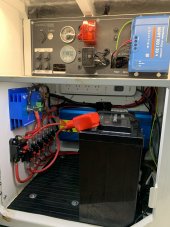Hi guys,
Im new to this forum discussion thing and I couldn’t find what I was thinking of doing.
I’ve got a camper trailer with a Victron MPPT 30A, 170ah Renogy Lithium battery, 200w flex solar panel and a 2000w Inverter that just died. During lockdown it’s sitting there doing nothing.
I was thinking of running a lead to it and power my laundry and some of the kitchen, which has a freezer, washing machine and fridge. Getting an average 700w to 1000w a day.
I’m getting another 170ah Renogy lithium battery so 350ah all up and a 3000w Renogy Inverter. Having it run all day, everyday, is this safe to do?
I know it will reduce the cycles of the battery and the life of the 3000w Inverter but would it do any long term damage to the batteries or inverter?
Just want to put it to use while I’m stuck at home.
Im new to this forum discussion thing and I couldn’t find what I was thinking of doing.
I’ve got a camper trailer with a Victron MPPT 30A, 170ah Renogy Lithium battery, 200w flex solar panel and a 2000w Inverter that just died. During lockdown it’s sitting there doing nothing.
I was thinking of running a lead to it and power my laundry and some of the kitchen, which has a freezer, washing machine and fridge. Getting an average 700w to 1000w a day.
I’m getting another 170ah Renogy lithium battery so 350ah all up and a 3000w Renogy Inverter. Having it run all day, everyday, is this safe to do?
I know it will reduce the cycles of the battery and the life of the 3000w Inverter but would it do any long term damage to the batteries or inverter?
Just want to put it to use while I’m stuck at home.




